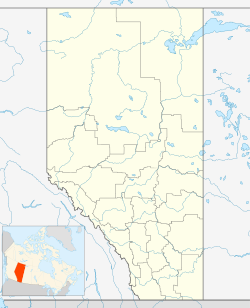Hardisty, Alberta
| Hardisty | |
|---|---|
| Town | |
| Town of Hardisty | |
| Location of Hardisty in Alberta | |
| Coordinates: 52°40′30.2″N 111°18′12.4″W / 52.675056°N 111.303444°WCoordinates: 52°40′30.2″N 111°18′12.4″W / 52.675056°N 111.303444°W | |
| Country |
|
| Province |
|
| Region | Central Alberta |
| Census division | 7 |
| Municipal district | Flagstaff County |
| Incorporated | |
| • Village | December 11, 1906 |
| • Town | November 9, 1910 |
| Government | |
| • Mayor | Anita Miller |
| • Governing body | Hardisty Town Council |
| • MP | Kevin Sorenson |
| • MLA | Wes Taylor |
| Area (2016) | |
| • Land | 5.13 km2 (1.98 sq mi) |
| Elevation | 615 m (2,018 ft) |
| Population (2016) | |
| • Total | 554 |
| • Density | 108/km2 (280/sq mi) |
| Time zone | MST (UTC-7) |
| Postal code span | T0B 1V0 |
| Area code(s) | -1+780 |
| Highways |
Highway 13 Highway 881 |
| Waterway | Battle River |
| Website | Official website |
Hardisty, Alberta is a town in Flagstaff County in Alberta, Canada. It is located in east-central Alberta, 111 kilometres (69 mi) from the Saskatchewan border, near the crossroads of Highway 13 and Highway 881, in the Battle River Valley. Hardisty is mainly known as a pivotal petroleum industry hub where petroleum products such as Western Canada Select blended crude oil and Hardisty heavy oil are produced and traded.
The Town of Hardisty was named after Senator Richard Hardisty. It began in 1906 as a hamlet, and officially became a town in 1911.
The first people we know of to live in the Battle River Valley were the native First Nations. This country was the wintering grounds for thousands of buffalo, moose, elk and deer, which attracted these people to the area.
The Town of Hardisty owes its existence to the Canadian Pacific Railway. About 1904 the surveyors began to survey the railroad from the east and decided to locate a divisional point at Hardisty because of the good water supply from the river.
Although this was a trading centre as early as 1904, it became a boom town by 1906, spawned by the influx of workers who were building the CPR. By the fall of 1906 the rail line reached Hardisty from Daysland. Then began the task of building the bridge, a task which took about three years.
Settlers also began arriving in large numbers. During 1906 to 1907, Hardisty was referred to as a tent town because people lived in tents until lumber could be hauled in. Business places sprang up overnight and, as with many towns, they were built along the railroad track.
In the 2016 Census of Population conducted by Statistics Canada, the Town of Hardisty recorded a population of 554 living in 254 of its 401 total private dwellings, a −13.3% change from its 2011 population of 639. With a land area of 5.13 km2 (1.98 sq mi), it had a population density of 108.0/km2 (279.7/sq mi) in 2016.
...
Wikipedia

